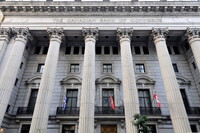| dc.description | St. James Street (officially rue Saint-Jacques) is a major street in Montreal, Quebec, Canada. The street has had two official names: St. James in English (never spelled "Saint") for St. James's London and Saint-Jacques in French. Both names are sometimes used in English, though Saint-Jacques is now more common for current geographical reference and St. James is usually used for reference to its historic importance as a financial district. A main thoroughfare passing through Old Montreal, the street was first opened in 1672. In the second half of the 19th century and the first half of the 20th century, St. James Street was the centre of Montreal's financial district and where several major insurance, banking, and trust companies built their Canadian head offices. At the time of its construction in 1928, the new head office of the Royal Bank of Canada at 360 St. James Street was the tallest building in the British Empire. Today, the stretch of St. Jacques Street between McGill Street and Saint Laurent Boulevard is still notable mostly for its grand Neo-Classical buildings. More modern buildings include the Montreal World Trade Centre and the Stock Exchange Tower. Farther west, St. Jacques Street runs through the residential neighbourhoods of Little Burgundy, Saint-Henri, Notre-Dame-de-Grâce and Lachine.; St. James Street (officially rue Saint-Jacques) is a major street in Montreal, Quebec, Canada. The street has had two official names: St. James in English (never spelled "Saint") for St. James's London and Saint-Jacques in French. Both names are sometimes used in English, though Saint-Jacques is now more common for current geographical reference and St. James is usually used for reference to its historic importance as a financial district. A main thoroughfare passing through Old Montreal, the street was first opened in 1672. In the second half of the 19th century and the first half of the 20th century, St. James Street was the centre of Montreal's financial district and where several major insurance, banking, and trust companies built their Canadian head offices. At the time of its construction in 1928, the new head office of the Royal Bank of Canada at 360 St. James Street was the tallest building in the British Empire. Today, the stretch of St. Jacques Street between McGill Street and Saint Laurent Boulevard is still notable mostly for its grand Neo-Classical buildings. More modern buildings include the Montreal World Trade Centre and the Stock Exchange Tower. Farther west, St. Jacques Street runs through the residential neighbourhoods of Little Burgundy, Saint-Henri, Notre-Dame-de-Grâce and Lachine. Source: Wikipedia; http://en.wikipedia.org/wiki/Main_Page (accessed 6/17/2009) | en_US |


